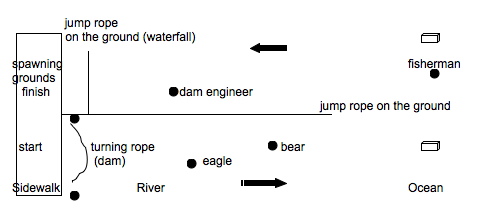Hooks and Ladders
Summary
This activity models the life cycle of the pacific salmon. It shows the affect of man-made changes in an environment on the living system.
Materials
- 3 jump ropes (long ones, PE departments frequently have them)
- 3 boxes poker chips or cardboard tokens
- 2 baseball caps or headbands
- a video showing migrating salmon-"The Power of Water" by National Geographic is a good one.
Background for Teachers
Pacific salmon are unusual because they spend part of their life in fresh water and part in seawater. They hatch in the upper reaches of fresh water streams, migrate downstream to the ocean, live in the ocean for 4-7 years and then return to the stream from which they hatched. Because of the activities of man, the journey has been made very difficult and the numbers of salmon that are able to complete it have seriously declined. The declining numbers of salmon affect several food chains that depend on them including that of man. Some research has indicated that the migration of salmon is a way nutrients from the ocean are "shared" deep onto land ecosystems.
Instructional Procedures
Attachments
- Ask students what they know about the life cycle of the salmon. Generate a graphic diagram on the board from their comments.
- Explain that the students will be modeling the life cycle of the salmon in a class activity. Ask for volunteers for 4 "jobs": a bear, an eagle, a fisherman and a hydroelectric engineer. Give each student a symbol of their job such as a hat, headband or box (boat) for the fisherman to put a foot in and drag around. You also need 2 students to turn the jump rope that is the dam.
- Go outdoors and set up a course that looks like this. It should be big enough for your students to run in freely without running into each other. The poker chips should be in one box in the "ocean". The other box should be 20 feet from the first.

- The class will gather on the sidewalk and the rope (dam) will turn. The students need to run through it without being hit. If they are hit they go stand between the dam engineer and the waterfall. The engineer is responsible for the lining the students up between herself and the waterfall. This will create the "fishladder".
- Students who survive the dam may be eaten by the bear or eagle. If the students are tagged during this time they go join the fish ladder.
- Students who make it to the ocean need to take a poker chip from one box to another to model survival for each year. If the fisherman tags them out during this time, they need to join the fish ladder. The fisherman must keep his foot in the boat box.
- A student who manages to "live" for 3 years in the ocean can negotiate the fish ladder by weaving through the students lined up in it. The dam engineer should have 6 students lined up before the waterfall.
- The students must broad jump the waterfall to succeed to the spawning grounds. Often, few students make it this far.
- Students often develop strategies to aid their survival that are typical of real animals. They may learn to "school" as fish do to confuse predators. Point out to students that this is a real advantage to a small organism.
- Try the game again (students often ask for another chance) but change something. Add or remove parts like the dam, predators, or fisherman.
- Finish the activity with a class discussion or writing activity to answer the question "How do man made changes in an environment affect the living things such as salmon?"
Bibliography
Lesson Design by Jordan School District Teachers and Staff.
Updated: 02/03/2018


 UTAH EDUCATION NETWORK
UTAH EDUCATION NETWORK

 Justin
Justin Braxton
Braxton Dani
Dani Kayla
Kayla Katie
Katie Matthew
Matthew Rob
Rob Val
Val
